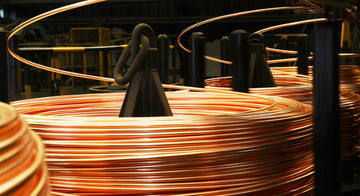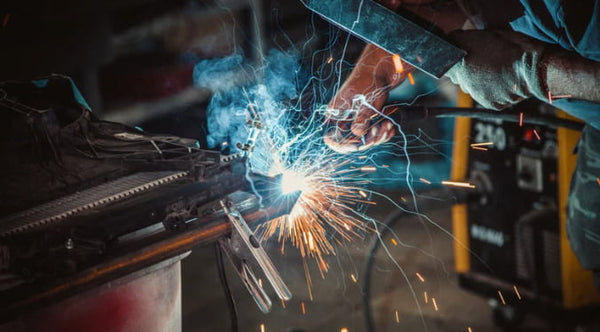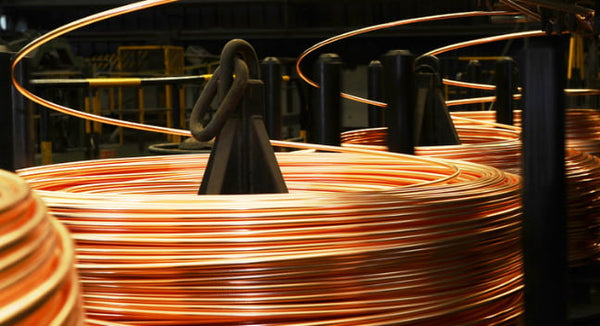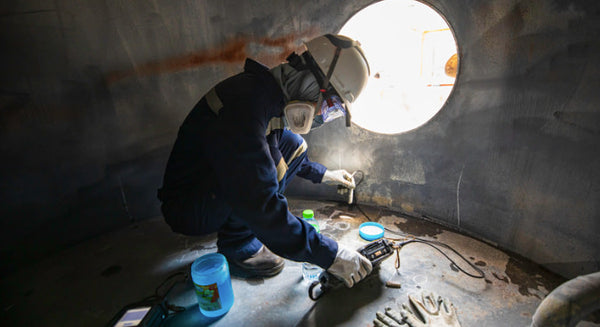
MIG wire sizes typically range from 0.023 to 0.045 inches, and selecting the appropriate size depends on the metal thickness being welded. The wire acts as the filler material that melts and joins metal pieces together during welding.
Choosing the right MIG welding wire size is very important for a strong and lasting weld. The size of the wire controls how much current can flow through it, which then influences how hot the weld gets and how deep it penetrates.
Using a wire that is too thin for the metal being welded can result in a weak weld while using a wire that is too thick can cause burn-through and excessive spatter.
In this article, we will guide you through the basics of MIG wire sizes and how to select the right size for your welding project.
We will also provide a MIG wire size chart to help you select the appropriate wire size for your welding project.
What is MIG Welding?

MIG welding is a process used to join metal pieces together. It stands for Metal Inert Gas welding and is also known as Gas Metal Arc Welding (GMAW). The process uses a wire electrode that is fed through a welding gun and melted by an electric arc. The melted wire is then used to join the metal pieces together.
MIG welding is a popular welding process because it is relatively easy to learn and can be used to weld a wide range of metals, including steel, stainless steel, and aluminum. It is also a fast process and can be used to weld in all positions.
It is important to note that using the wrong wire size can result in a weak and unreliable weld. Therefore, it is crucial to select the appropriate wire size for your welding project.

MIG wire sizes are measured in diameter and are typically expressed in inches or millimeters. The most common MIG wire sizes range from 0.023 to 0.045 inches for welding various metal thicknesses.
It's important to note that MIG wire size is not the only factor that determines the strength of a weld. Other factors such as the type of metal being welded, the welding technique used, and the shielding gas also play a role in the final outcome of the weld.
Matching wire sizes to MIG machines is also an important consideration. MIG machines are typically designed to work with specific wire sizes, so it's important to choose the right wire size for your machine. Using the wrong wire size can result in poor weld quality and may even damage your machine.
Factors Affecting the Choice of MIG Wire Size
The wire acts as a filler material that melts and joins metal pieces together during welding.
Here are some factors that influence the selection of wire size:
1. Material Thickness
The thickness of the material being welded is a crucial factor in determining the appropriate MIG wire size. Welding thicker material requires a larger diameter wire to ensure adequate penetration and a strong weld. On the other hand, welding thinner material requires a smaller diameter wire to prevent burn-through and distortion.
2. Joint Configuration
The joint configuration also plays a role in determining the appropriate wire size. For example, a butt joint requires more filler material than a lap joint. Therefore, a larger diameter wire may be needed for a butt joint to ensure adequate penetration and strength.
3. Welding Position
The welding position also affects the selection of wire size. For example, welding in the vertical or overhead position requires a smaller diameter wire to prevent drooping and ensure proper penetration. On the other hand, welding in the flat or horizontal position allows for the use of a larger diameter wire.
4. Type of Shielding Gas
Other factors that may influence the selection of wire size include the type of shielding gas being used, the type of metal being welded, and the welding technique being employed. It's important to consult a MIG wire size chart to ensure that the appropriate wire size is selected for the specific welding application.
Read related article: What is the Best Shielding Gas Used for MIG Welding?
Common MIG Wire Sizes and Their Applications
When it comes to selecting the right MIG wire size, it is crucial to understand the different sizes available and their applications.
Here are the most common MIG wire sizes and what each size is best suited for regarding different materials and thicknesses:
-
0.023 inches: This wire size is perfect for welding thin gauge materials, such as sheet metal, up to 3/16 inch. It is also ideal for welding on light to medium-duty materials, including automotive parts, exhaust systems, and farm equipment.
-
0.030 inches: This wire size is a popular choice for welding on materials ranging from 1/8 inch to 3/8 inch in thickness. It is suitable for welding on a variety of materials, including mild steel, stainless steel, and aluminum.
-
0.035 inches: This wire size is commonly used for welding on materials ranging from 3/16 inch to 1/2 inch in thickness. It is ideal for welding on thicker materials, such as structural steel, heavy equipment, and piping.
-
0.045 inches: This wire size is best suited for welding on materials that are 1/4 inch or thicker. It is commonly used for welding on heavy-duty materials, such as large structural components, heavy machinery, and thick-walled pipe.
Check MIG Wire Size Chart Guidelines

By understanding the different MIG wire sizes available and their applications, you can ensure that you are using the right wire size for your welding needs.
How to Choose the Right MIG Wire Size for Your Project

Choosing the right MIG wire size depends on the thickness of the material being welded. The thicker the material, the larger the wire size you will typically need.
This is because thicker materials require deeper penetration for a strong weld, which a larger wire can provide.
For example, if you're welding a 1/2 inch thick steel, you'd typically use a .045 gauge wire.
Here's a step-by-step guide on selecting the appropriate wire size based on specific project requirements.
-
Determine the metal thickness: The thickness of the metal you are welding is the most important factor in selecting the right MIG wire size. The thicker the metal, the larger the wire size you will typically need. For example, if you're welding a 1/2 inch thick steel, you'd typically use a .045 gauge wire.
-
Check the manufacturer's recommendations: Check the manufacturer's recommendations for the specific MIG wire size to use for the metal you are welding. This will ensure that you are using the appropriate wire size and will help you achieve the best results.
-
Consider the type of metal: The type of metal you are welding can also impact the wire size you need. For example, aluminum requires a larger wire size than steel due to its lower melting point.
-
Determine the type of welding you will be doing: The type of welding you will be doing can also impact the wire size you need. For example, if you are doing a lot of overhead welding, you may want to use a smaller wire size to reduce the amount of spatter.
- Consider the welding machine: The type of welding machine you are using can also impact the wire size you need. Some machines may only be compatible with certain wire sizes, so it's important to check the manufacturer's recommendations.
Tips for Working with Different MIG Wire Sizes

When it comes to MIG welding, choosing the right wire size is crucial for producing high-quality welds. Here are some tips for working with different MIG wire sizes:
1. Select the Right Wire Diameter
The wire diameter you choose will depend on the thickness of the metal you are welding. As a general rule, thinner metals require thinner wire, while thicker metals require thicker wire. Refer to a MIG wire size chart to determine the appropriate wire diameter for the job.
2. Adjust Machine Settings
Once you have selected the appropriate wire diameter, you will need to adjust your machine settings accordingly. This includes adjusting the voltage and wire feed speed. Consult your machine's manual for recommended settings based on the wire diameter you are using.
3. Use Proper Technique
To ensure a successful weld, it is important to use proper welding technique. This includes maintaining a consistent travel speed and keeping the wire at the correct angle. Practice on scrap metal before starting your project to get a feel for the technique required.
4. Be Mindful of Welding Position
Different welding positions require different wire sizes. For example, vertical welding typically requires a smaller wire diameter than horizontal welding. Be mindful of the welding position when selecting your wire diameter.
5. Consider the Type of Metal
The type of metal you are welding can also impact the wire diameter you should use. For example, welding aluminum typically requires a larger wire diameter than welding steel. Consult a MIG wire selection guide for recommendations based on the type of metal you are welding.
TIG Welding vs. MIG Welding Wire Selection
Two popular types of welding wire are TIG welding wire and MIG welding wire. While both are used for welding, they have some key differences that make them better suited for different applications.
Comparison Table
|
Feature |
TIG Welding Wire |
MIG Welding Wire |
|
Material Thickness |
Suitable for thin material |
Suitable for thick material |
|
Welding Speed |
Slower welding speed |
Faster welding speed |
|
Weld Quality |
High-quality welds |
Good quality welds |
|
Welding Position |
Suitable for all positions |
Limited to flat and horizontal positions |
|
Shielding Gas |
Argon or Helium |
Argon, CO2, or a mixture of both |
|
Filler Material |
Filler rod is added separately |
Filler wire is fed continuously |
TIG Welding Wire
TIG welding wire is typically used for welding thin materials, such as aluminum, stainless steel, and copper. It requires a higher level of skill and precision than MIG welding because the welder must hold the filler rod in one hand while operating the torch with the other.
TIG welding produces high-quality welds with excellent appearance and minimal spatter. It is suitable for welding in all positions and can be used with either argon or helium shielding gas.
MIG Welding Wire
MIG welding wire is generally used for welding thicker materials, such as steel and iron. It is easier to use than TIG welding because the filler wire is fed continuously, allowing for faster welding speeds.
However, the weld quality may not be as high as TIG welding, and there may be more spatter. MIG welding is limited to flat and horizontal positions and requires a shielding gas, which can be argon, CO2, or a mixture of both.
How do I know what MIG wire to use?
Choosing the correct MIG wire is crucial for achieving a successful weld. Here are some tips to help you determine which MIG wire to use:
-
Consider the material you are welding: Different metals require different MIG wires. For example, if you are welding mild steel, you will need a different MIG wire than if you were welding aluminum or stainless steel.
-
Determine the thickness of the metal: The thickness of the metal you are welding will determine the diameter of the MIG wire you should use. A MIG wire size chart can provide recommended wire diameters for different metal thicknesses.
-
Determine the type of welding you will be doing: If you are doing a lot of welding, you may want to consider using a spool of wire instead of individual wire. This will save you time and money in the long run.
-
Check the manufacturer's recommendations: The manufacturer of your welding machine will often provide recommendations for which MIG wire to use. Be sure to follow these recommendations to ensure a successful weld.
-
Consider the shielding gas: The type of shielding gas you use will also impact the type of MIG wire you should use. For example, if you are using a gas mix that is high in argon, you will need a MIG wire that is designed to work with that type of gas mix.
By considering these factors, you can choose the correct MIG wire for your welding project and achieve a successful weld.
Conclusion
In conclusion, selecting the right MIG wire size is crucial for successful welding. The wire acts as the filler material that melts and joins metal pieces together during welding. Different wire sizes are suitable for different metal thicknesses. It is essential to match the wire diameter with the metal thickness to ensure a robust and long-lasting weld.
Using the wrong wire size can lead to several problems, including poor penetration, uneven welds, and even weld failure. Therefore, it is essential to experiment carefully with different sizes while adhering to safety standards.
Remember that MIG welding is a precise process that requires the right tools, technique, and skill. As such, it is critical to follow the manufacturer's recommendations and guidelines for wire size and other settings.
Visit ArcCaptain for premium quality MIG welding wires in a variety of sizes. Get in touch today for more information and to explore our products!
Frequently Asked Questions
What is 0.8 mm MIG wire used for?
0.8 mm MIG wire is commonly used for welding thinner metal sheets, ranging from 0.6 mm to 3 mm in thickness. This wire size is ideal for welding materials such as car body panels, thin steel plates, and light-duty welding applications.
Which is better 0.8 mm or 0.9 mm MIG wire?
The choice between 0.8 mm and 0.9 mm MIG wire depends on the thickness of the metal being welded. 0.8 mm wire is suitable for welding thin metal sheets up to 3 mm thick, while 0.9 mm wire is better suited for thicker metals up to 6 mm thick. It is important to match the MIG wire diameter to the thickness of the metal being welded for optimal results.
What size wire is common to use with a MIG welder?
The most common MIG wire sizes used with a MIG welder are 0.8 mm and 0.9 mm. These wire sizes are versatile and can be used for a wide range of welding applications. However, the wire size should be selected based on the thickness of the metal being welded.
What is 0.6 MIG wire used for?
0.6 mm MIG wire is commonly used for welding thinner metal sheets, ranging from 0.6 mm to 1.5 mm in thickness. This wire size is suitable for welding materials such as car body panels, thin aluminum plates, and light-duty welding applications.
What is 0.9 MIG wire used for?
0.9 mm MIG wire is commonly used for welding thicker metal sheets, ranging from 3 mm to 6 mm in thickness. This wire size is ideal for welding materials such as heavy-duty structural steel, thicker aluminum plates, and other heavy-duty welding applications.
